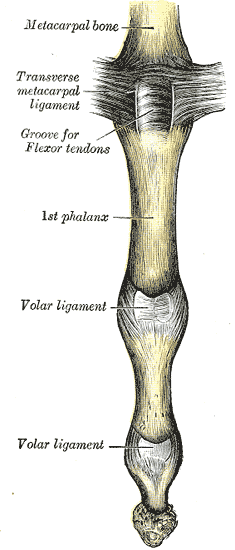| Deep transverse metacarpal ligament | |
|---|---|
 Metacarpophalangeal articulation and articulations of digit. Volar aspect. | |
| Details | |
| From | Head of metacarpal |
| To | Head of adjacent metacarpal |
| Identifiers | |
| Latin | ligamentum metacarpeum transversum profundum |
| TA98 | A03.5.11.504 |
| TA2 | 1838 |
| FMA | 42459 |
| Anatomical terminology | |
The deep transverse metacarpal ligament (also called the deep transverse palmar ligament) connects the palmar surfaces[ citation needed ] of metacarpophalangeal joints of all the fingers of the hand except the thumb. [1]





